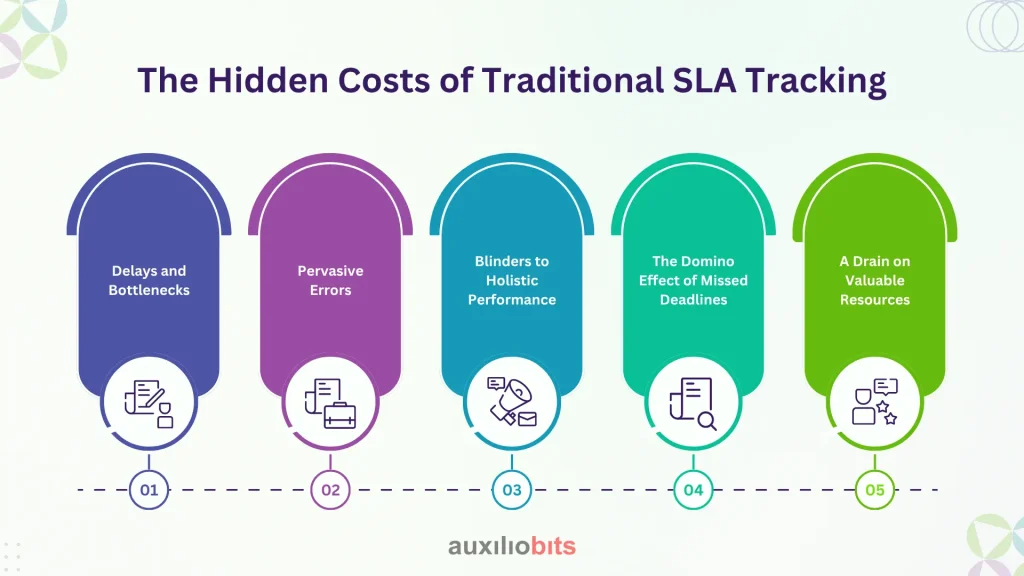
Key Takeaways
- Traditional SLA tracking methods are inefficient and costly, often plagued by delays, errors, siloed data, and missed deadlines—leading to customer dissatisfaction and financial penalties.
- LLM-powered agents transform SLA tracking by automating data extraction, proactively monitoring service commitments, and facilitating seamless, real-time cross-departmental communication.
- These agents provide predictive analytics and generate granular performance insights, helping organizations anticipate risks, optimize workflows, and make data-driven decisions.
- Departments across the board—from IT and customer service to legal and operations—benefit significantly from reduced manual work, faster response times, and enhanced compliance.
- Implementing LLM agents successfully requires a clear SLA framework, integrated data access, ongoing training, strong privacy controls, and a phased rollout strategy.
In today’s time, where customer demands keep on fluctuating every single day and operational efficiency is of utmost importance, it is essential to understand that service legal agreements are not just simple papers. They are major elements when it comes to building trust with the customers and offering the services they deserve. Nevertheless, finalizing these agreements, especially when a plethora of departments have to review everything, is one of the challenges.
It’s been a while since firms have experienced major challenges. But large language models have worked wonders for companies. This is because LLMs have helped them seek smart and innovative solutions to overcome hurdles.
Also read: Using LLMs to Extract and Validate Data from Patient Charts: A Technical Implementation Guide.
The Hidden Costs of Traditional SLA Tracking
For decades, companies have adjusted to the limitations of conventional SLA tracking strategies that depended on manual procedures, communication channels, and disparate systems. But due to all of this, companies had to spend a lot of money, and that resulted in budget issues too. On the other hand, they also faced obstacles like:

Delays and Bottlenecks:
Let’s understand this with an example. A customer support ticket calls for inputs from the IT member, product development, and billing. If it is a conventional setup, every single handover asks for updates from all the departments. This introduces delays as approvals are pending, and there is no status. As a result, the SLA adherence is hampered, and there are several bottlenecks that a firm has to overcome.
No matter how many times you review something, there is a chance that human errors occur, whether major or minor. Misinterpreted email threads, spreadsheet entries, and miskeyed data—issues like these can lead to wrong SLA calculations, incorrect reports, and missed deadlines. These mistakes give rise to severe penalties and can also compromise compliance.
Blinders to Holistic Performance:
With each department often using its own tools and tracking methods, getting a unified, real-time view of an SLA’s progress across the entire organization becomes incredibly difficult. This siloed approach means senior management often lacks the comprehensive insights needed to identify systemic issues or optimize cross-functional workflows.
The Domino Effect of Missed Deadlines:
Failing to meet an SLA can trigger a chain reaction. A missed IT support resolution can impact a sales demo, leading to a lost opportunity. Beyond financial penalties, repeated SLA breaches erode customer trust, damage brand reputation, and can lead to customer churn.
A Drain on Valuable Resources:
The sheer administrative overhead involved in manual SLA tracking—updating spreadsheets, sending reminders, chasing approvals, compiling reports—consumes significant time and effort from skilled employees. These resources could be far better utilized on strategic initiatives that drive business growth.
How LLM-Powered Agents Engineer a Transformation in SLA Tracking?
Large Language Model (LLM)-powered agents represent a paradigm shift, leveraging advanced artificial intelligence to automate, streamline, and intelligently manage the entire SLA lifecycle. Their capabilities are truly revolutionary:
Automated, Intelligent Data Extraction:
Unlike simple keyword searches, LLMs possess a deep understanding of language context. They can intelligently scan and extract critical SLA-related information from a myriad of sources, regardless of their format. This includes parsing complex legal clauses in contract documents, identifying resolution times in free-form email correspondence, extracting task assignments from chat logs (e.g., Slack, Teams), pulling incident priorities from IT ticketing systems (e.g., ServiceNow, Jira), and recognizing payment terms from invoicing platforms. They can even identify the “responsible party” or the “next action” from conversational data.
Real-time Intelligent Monitoring and Proactive Alerts:
LLM agents don’t just extract data; they continuously monitor the live status of each SLA. Imagine an agent tracking a customer support ticket with a 2-hour response SLA. If no response is logged after 90 minutes, the agent can automatically flag it, escalate the issue to the team lead, or even send a pre-drafted “pending response” email to the customer, all in real-time. This proactive approach ensures that potential breaches are identified and addressed before they occur, transforming reactive problem-solving into proactive issue prevention.
Seamless Cross-Departmental Communication Facilitation:
A common bottleneck in SLA adherence is miscommunication between departments. An LLM agent can act as a neutral, intelligent translator. For instance, if the IT department updates a ticket with highly technical jargon, the LLM can rephrase it into clear, concise language understandable by the customer service team, ensuring everyone is on the same page. They can also facilitate automated handoffs, ensuring the right information reaches the right person at the right time, minimizing manual coordination efforts.
Unlocking Predictive Analytics for Risk Mitigation:
By analyzing historical SLA performance data—successful completions, common delays, specific departments or processes that frequently cause bottlenecks—LLM agents can identify emerging patterns and predict potential future compliance risks. For example, if a particular IT system consistently experiences downtime on Tuesdays, the agent might flag upcoming SLAs that depend on that system, allowing teams to allocate additional resources or prepare contingencies. This foresight enables organizations to take preventative measures, optimizing resource allocation, adjusting workflows, and mitigating risks before they escalate.
Granular Performance Reporting and Actionable Insights:
LLM agents can generate highly detailed and customizable reports on SLA performance. These reports go beyond simple pass/fail metrics. They can pinpoint the root causes of delays (e.g., “90% of missed sales demo SLAs are due to late availability from the product team”), highlight top-performing teams, identify recurring bottlenecks in specific processes, and even quantify the financial impact of SLA adherence or non-compliance. These insights are invaluable for strategic decision-making, process improvement, and performance optimization.
Automated Workflow Orchestration for Efficiency:
The power of LLM agents extends beyond mere tracking. When integrated with existing workflow automation platforms (e.g., RPA tools, Zapier, Microsoft Power Automate), they can trigger automated actions based on SLA conditions. For example, if a critical bug fix SLA is missed, the agent could automatically escalate the issue to senior management, create a new high-priority ticket in Jira, send an apology email to the affected customers, and schedule a follow-up meeting—all without human intervention. This significantly reduces manual effort and accelerates issue resolution.
Benefits Across Every Department
The implementation of LLM-powered agents for SLA tracking ripples across the entire organizational structure, delivering tangible benefits to every department:
Imagine faster incident resolution times due to proactive alerts and automated diagnostic information gathering. Improved system uptime is achieved through predictive maintenance suggestions. Better management of service requests becomes possible with intelligent routing and prioritization, leading to higher internal and external customer satisfaction.
For Customer Service:
Experience dramatically faster response times as agents auto-triage and suggest relevant knowledge base articles. Personalized support becomes the norm as LLMs quickly surface customer history and preferences. This directly translates to increased customer satisfaction and loyalty, turning customer service into a competitive advantage.
For Sales:
Streamlined lead qualification and automated follow-up ensure no hot lead falls through the cracks. Quicker quote generation is possible through automated data retrieval for pricing. More efficient client onboarding processes are supported by automated task assignments and progress tracking, reducing time-to-value for new customers.
For Operations:
Optimized supply chain management can be achieved by tracking supplier SLAs in real-time, anticipating potential delays. Improved delivery times are a direct result of better coordination and proactive problem-solving. Better resource utilization becomes possible by predicting demand fluctuations and allocating resources accordingly.
For Legal/Compliance:
Automated documentation of SLA adherence provides an indisputable audit trail, significantly reducing legal risks. Ensuring regulatory compliance becomes less burdensome as agents flag potential non-compliance issues and automatically generate necessary reports, providing peace of mind.
Navigating the Path to Implementation: Key Strategic Considerations
While the promise of LLM-powered agents is compelling, a successful implementation requires a thoughtful, strategic approach:
Crystal Clear SLA Definition:
Before introducing any technology, ensure your SLAs are meticulously defined. Are they SMART (Specific, Measurable, Achievable, Relevant, Time-bound)? Is there universal agreement across all stakeholders on what constitutes success or failure for each SLA? Ambiguity will hinder even the most advanced AI.
Robust Data Integration Strategy:
The power of LLMs lies in their access to comprehensive data. Develop a clear plan for integrating data from all relevant departmental systems—CRM, ERP, ticketing, communication platforms, etc. – to provide a unified data source for the LLM agents. Consider APIs, data lakes, or middleware solutions.
Agent Training and Fine-tuning:
While pre-trained, LLMs will need to be fine-tuned on your organization’s specific SLA terms, internal processes, unique communication styles, and industry-specific jargon. This iterative training process ensures the agents accurately understand and interpret your context.
Prioritizing Security and Data Privacy:
LLM agents will handle sensitive operational and potentially customer data. Implement stringent security measures, including data encryption, access controls, and compliance with relevant data privacy regulations (e.g., GDPR, CCPA). Data governance policies are crucial.
Strategic Phased Rollout:
Rather than a “big bang” approach, consider a phased implementation. Start with a pilot program in a single, well-defined department or for a specific type of SLA. This allows you to refine the agents, gather feedback, and demonstrate value before scaling to other areas of the organization.
The Future of SLA Management is Here
LLM-powered agents are more than just a technological innovation; they represent a fundamental paradigm shift in how businesses can achieve unprecedented levels of operational excellence. By automating the inherent complexities of SLA tracking, they liberate organizations from tedious manual tasks and reactive firefighting. They empower teams to move beyond simply meeting deadlines to proactively optimizing workflows, fostering seamless cross-departmental collaboration, and ultimately delivering superior experiences for both customers and internal stakeholders.








